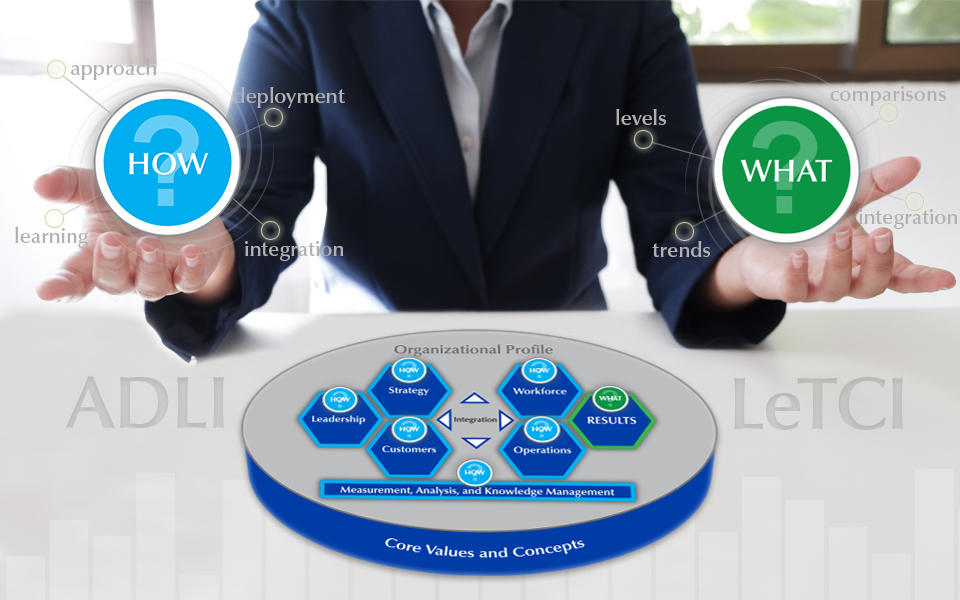Blogrige
The Official Baldrige Blog

For people who have known me for years, you probably never thought you would hear me say, "The Baldrige Criteria for Performance Excellence are an insufficient guide for achieving improvement and, hopefully, excellence." But the statement is true and it is not a new epiphany for me. The Criteria ask how your organization accomplishes everything it needs to do and define what that "everything" is. How has a simple meaning in most contexts: a description of your approach or method. But that is not the full meaning of how, when you are characterizing an organizational process. The full meaning is revealed when the Criteria are combined with the Baldrige Scoring Guidelines which add dimensionality to how. Then the picture is both sufficient and all-encompassing.
Before continuing the explanation, let me provide context by explaining why I am writing this blog....
My Email Exchange
I recently had a very thoughtful email exchange with Bob Scanlon, a long-time Baldrige examiner, senior examiner, and alumni examiner. The basic topic was new and improved process adoption in an organization, process standardization throughout the organization, and adoption of benchmarked processes in large, geographically dispersed organizations (and smaller ones, as well). The basic problem is that well-defined processes are not uniformly and effectively deployed throughout the organization, and improvements are frequently localized or reinvented at multiple places in an organization. Knowledge transfer is poor and a lot of rework or inefficiencies occur. Bob's thought-provoking question was, are new how questions needed in the criteria to address these issues?
The Meaning of How
After giving Bob's question some thought, my answer was "no." We do not need new Criteria questions to address these issues. The answer lies in responding to the existing process questions and understanding the meaning of how, which the Baldrige Glossary of Key Terms defines as:
How
The systems and processes that your organization uses to achieve its mission requirements. You should include information on approach (methods and measures), deployment, learning, and integration.
Approach (A), Deployment(D), Learning (L), and Integration (I) or ADLI are the four dimensions of the Baldrige process item scoring guidelines. The proper answer to a how question requires information on the approach, including
- measures of effectiveness and efficiency
- deployment of the approach to relevant work units throughout the organization
- learning through cycles of evaluation and improvement, innovation, and sharing with all relevant work units
- integration by aligning the approach with organizational needs and harmonizing plans, processes, information, resource decisions, actions, and analyses to support organization-wide goals
The ADLI dimensions are described in detail in the Baldrige Scoring Guidelines. Organizational maturity, by way of a score, is measured by progress in achieving these four ADLI dimensions. However, the ADLI dimensions are not merely a scoring companion to the Baldrige Criteria; they provide the defining characteristics of the word how. The Baldrige Criteria for Performance Excellence are insufficient if one does not understand the meaning of how and its role in defining process excellence. This meaning and role in performance excellence is described in the Scoring Guidelines. Therefore, they should be used as an integral part of Criteria implementation, even if your organization is not trying to score your level of performance.
The questions posed in Bob Scanlon's email are addressed by the deployment and learning dimensions of responding to how.
The next logical question might be, "Are the Scoring Guidelines also important in answering the results questions in the Criteria?"
What about Results?
The same concept of Criteria and Scoring Guidelines complementarity applies to the meaning of what, when asking what are your results. What are your results has a simple meaning in most contexts: tell me your level of performance. To understand the full meaning of what when describing results, organizations should look at the scoring dimensions for results: Levels (Le), Trends (T), Comparisons (C), and Integration (I), or LeTCI (Let's see our progress). The proper answer to a results question requires information about the
- level of current performance
- trend in your performance over time (Are you getting better, worse, or staying the same?)
- comparison of your organization's performance to that of competitors, or other similar organizations, or, possibly, best-in-class performance
- integration, the extent to which your results measures address important performance requirements relating to products, customers, markets, processes, action plans, and organization-wide goals
Systems Perspective
When your organization defines and standardizes a process, do you truly define how it will be accomplished? When your organization assesses its results, do you truly measure what has been accomplished? ADLI and LeTCI complement the Baldrige Criteria and permit the systems perspective.
 Credit:
madpixblue/Shutterstock
Credit:
madpixblue/Shutterstock

To respond to the thought-provoking question from my friend, Bob Scanlon, the reputation and sustainability of your organization's brand depend on your answers to the criteria questions, fully understanding the meaning of how and what!
Enrich Your Career and Improve Organizational Performance


Become a Baldrige Examiner
If you are looking for a one-of-a-kind professional development and networking opportunity, and the chance to make a meaningful contribution to organizational improvement and U.S. competitiveness, apply to serve as a volunteer on the Baldrige Board of Examiners.
Application Opens: November 2018
The 2019 Board of Examiner Application will open in November 2018 and close in January 2019.
About the author
Related Posts
Comments
Harry,
This is a great article and I really like the way you distinguished the key components of "How" (ADLI) & "Results" (LeTCI). I would offer a recommendation to use a different graphic to symbolize systems thinking. If you were to place directional arrows on each gear, the "system" would not feasibly work as shown. i realized this image has been used repeatedly by many great leaders like you, but I also think there is a better way to depict this!
Best wishes!
Thanks for the comment. I agree, the image was chosen as symbolic, without careful attention to its Deployment. I will take this as a cycle of Learning, and an indicator of poor Integration!
Hello Harry
If I may contribute to this discussion I would say the following:
The “how” here is based on the “process” level, but there is no a “how” on organization level to address the approach of embedding “Baldrige" into the current management model. Adopting the project management approach enables the organization to plan and define the “Baldrige” deployment stages, the prioritized deliverables, the needed budget, resources, and solutions to adopt the "Baldrige" criteria on an organization level.
I have seen organizations started Baldrige improvement initiative without any project management approach; then the outcome results had worsened more it improved on the organization level. The reasons of failure included the focus on the process rather than on organization, lack of prioritization, lack of defined objectives, lack of defined target deliverables on boxed time, lack of resources and weak management commitment. If we analyze the common root causes of all of these reasons, it will spell the lack of project management approach.
I suggest adding a new “how” to ask about the approach for “Deploying” the Baldrige Criteria onto the current "Organization” management level.
What do you think Harry?
Thanks for the comment. I agree with your concerns. The Baldrige Criteria address these concerns through applying a systems perspective in the framing of the Criteria questions and through the Integration dimension in scoring.
HH, when and why did you get repurposed as a "Cheermudgeon?"
The title is self-proclaimed. It has been in use ever since Blogrige began!






Agree! The Criteria are INSUFFICIENT in improving performance if used as a CHECKLIST. Companies and examiners must understand the Framework, ADLI, and LeTCI. Too often the Criteria is treated as a checklist. Categories become their own silos. Many examiners have a hard time challenging ADLI examples given in the application. They call it a cycle of improvement, so that moves them up on scoring guidelines. The rigor of was the improvement efficient and effective in driving desired results is often overlooked. Did Category 4 help identify where improvements are needed and where those are addressed? I often say... Baldrige doesn't work and neither does Weight Watchers if I don't follow the process ...monitor activity (exercise), input (food), and results (weight and dimensions.) Baldrige is the best framework and continues to improve!